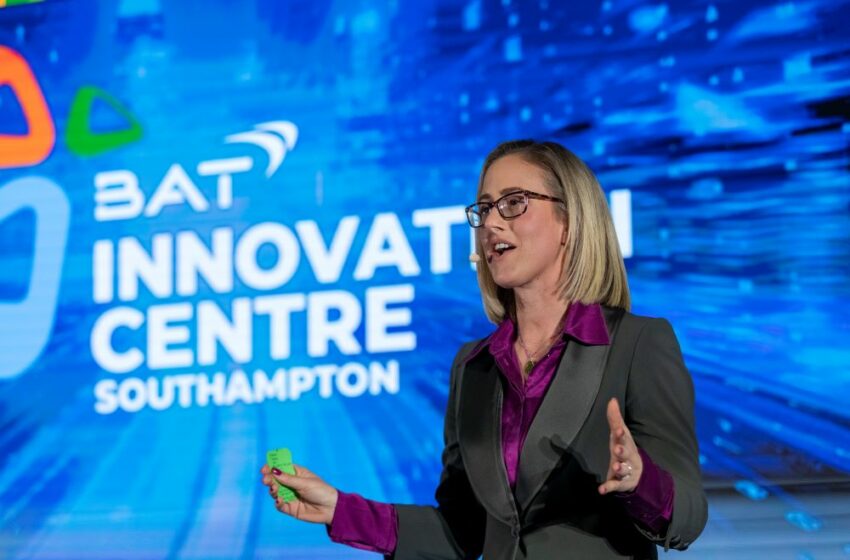
BAT’s Danielle Tower shares her views on the tremendous opportunity presented by tobacco harm reduction.
By George Gay
Ahead of the 2024 CORESTA Congress that was held in Scotland Oct.13-17 under the theme “Advancing Tobacco Harm Reduction through Scientific Collaboration,” Tobacco Reporter took the opportunity to interview Danielle Tower, group head of scientific and regulatory affairs at BAT, the host of the Congress.
Tobacco Reporter: In March, BAT went public with the opening of its new U.K. Innovation Centre in Southampton, U.K. (see “Driving Transformation,” Tobacco Reporter, May 2024). More recently, with your Omni initiative, you have presented a summary of BAT’s progress toward making “A Better Tomorrow by Building a Smokeless World.” And last month, you hosted the CORESTA conference under the banner “Advancing Tobacco Harm Reduction Through Scientific Collaboration.” This is all very praiseworthy, but do you have evidence that your tobacco harm reduction (THR) messages are getting through to those people making regulatory decisions about tobacco and nicotine?
Tower: Governments, the public health community as well as manufacturers like BAT and their business partners have a key role to play in maximizing the potential of smokeless products to contribute to tobacco harm reduction.
In July 2023, the FDA [U.S. Food and Drug Administration] has authorized the marketing and sale of our vapor product Vuse Alto with Golden Tobacco and Rich Tobacco flavors in the United States. This is good news for adult smokers, who would otherwise continue to smoke, and for public health.
Evidence-based regulation requires a comprehensive scientific assessment, from data that assesses the health impact of new products, to the impact on the population, including users of new products and nonusers of nicotine products.
At BAT, we are focused on driving awareness and understanding of our science across multiple scientific and other nonconsumer audiences. We believe that by being open and transparent with our data, we can meaningfully contribute to the discussion on tobacco harm reduction.
Even in the U.K., where regulations have tended toward the pro-THR, the signs are that things are going to get more difficult for those offering smokeless alternatives to combustible tobacco products. How can you navigate this potentially more hostile regulatory landscape in such a way as to take THR forward?
We believe that tobacco harm reduction—the switching of smokers, who would otherwise continue to smoke, to alternatives with a reduced-risk profile—is the best way to reduce the harm associated with smoking cigarettes.
We have a vast body of scientific evidence to substantiate the reduced-risk profile of our smokeless products. And, when required, we conduct new science to support our regulatory submissions.
BAT is in favor of progressive regulation—based on the best available scientific evidence—allowing adult smokers to have access to smokeless alternative products while providing consumers with high product standards and preventing underage access.
The U.K. is a tobacco harm reduction success story. The number of smokers is at an all-time low—6 million—and nearly 3 million people have switched to vaping in the last five years. We are calling for smart regulation that allows smokers to have access to smokeless alternatives while providing consumers with high product standards and guarding against underage access. One of our proposals is a retail licensing system—similar to alcohol. Most importantly, good regulation must be accompanied by robust enforcement—otherwise, it is unlikely to be effective.
And how do you navigate your way in jurisdictions where regulations are not as supportive of THR as they have been to date in the U.K.?
Harm reduction approaches have produced diverse opinions from numerous stakeholders. We encourage anyone interested in learning more about tobacco harm reduction to read more and consider the broadest range of available viewpoints.
Regulation should be based on the best available scientific evidence. And lessons can be learned from countries like Sweden, the U.K., New Zealand and Canada that have embraced tobacco harm reduction and have experienced an associated acceleration in the decline of smoking rates.
One of the problems with nicotine product regulations seems to be that they are not always fully enforced, something that can unfairly put legitimate companies in a bad light in the general media. Again in the U.K., rogue manufacturers seem able to market noncompliant products because imports, compliance and retail sales, including to those underage, are not properly policed. Is there anything that you can do to turn this around?
Yes, I think there are three main challenges: Firstly, the lack of awareness or acceptance of tobacco harm reduction. Many prestigious public health organizations are in favor of THR as the way to reduce the harm associated with smoking cigarettes for those consumers who would otherwise continue to smoke.
Secondly, the lack of enforcement. Regulation must be well enforced with strong sanctions for those who don’t comply. Otherwise, situations as seen in the United States arise where the majority of the vapor market consists of illegal, illicit disposable vapes.
And thirdly, the lack of flexibility to keep pace with innovation. Regulatory frameworks often struggle to keep pace with a fast-evolving, consumer-led market. It’s important to cater for innovation so that adult smokers have access to the best available smokeless alternatives, which has the potential to accelerate tobacco harm reduction.
Your new Innovation Centre involved a considerable investment, but, in fact, it is only a part of the total investment needed to bring forward efficacious alternative smokeless products. How do you ensure that these investments are used to the best advantage in producing good products while keeping investors happy? Do you mainly seek to improve the categories of alternative smokeless products already established, or are you involved in blue-sky projects that might come up with revolutionary products?
Consumer choice is driving the transformation of the tobacco industry. Adult smokers are more likely to switch to a product that delivers comparable satisfaction. That is why we are obsessed with innovation and invest £300 million [$392.27 million] a year in the development of our smokeless products. The Innovation Centre in Southampton will collaborate with BAT’s Innovation Centres in Shenzhen and Trieste [see “Shaping Tomorrow,” Tobacco Reporter, April 2023] to anticipate and meet the needs of consumers through science, technology and innovation.
I can’t disclose our innovation pipeline, but we are constantly innovating and utilizing new technology to improve our portfolio of smokeless products.
You compete in most if not all the smokeless product categories and, at the opening of your new Innovation Centre, presentations were given concerning the seemingly impressive levels by which the health risks associated with the consumption of these products is potentially lower than that of smoking combustible cigarettes. But this sort of information does not seem to see the light of day too often. Can this situation be turned around?
Already today, several public health organizations and regulators are supporting the use of smokeless products. However, to ensure that the full potential of the tobacco harm reduction opportunity is realized, much more focus is required by regulators to ensure that adult smokers in all markets across the world have access to smokeless products and accurate information about their relative risk—so they can make informed decisions about switching.
We publish the findings of science in peer-reviewed publications and present the results at conferences. This helps to informs other scientists working in the field and those undertaking evidence reviews.
Governments have an important role to play as a trusted source of information. The U.K. is a good example. The government has undertaken reviews of the scientific evidence on vaping—publishing its key findings (OHID evidence review). And the National Health Service has a page dedicated to vaping as a means of promoting THR—covering the myths and facts (Vaping myths and the facts—Better Health—NHS [www.nhs.uk]).
Questions have been asked in the recent and not-so-recent past about the relevance of CORESTA in the current tobacco/nicotine environment. Do I take it that, in hosting this year’s congress, you are giving a stamp of approval to this organization and the idea of scientific co-operation even within a highly competitive industry?
It is a great honor for BAT to host the 2024 CORESTA Congress concentrating on the theme of “Advancing Tobacco Harm Reduction Through Scientific Collaboration.” We are proud to welcome around 500 attendees to the congress, bringing together member and nonmember organizations from over 30 countries, including companies, research institutes, laboratories, associations and regulatory bodies. Our focus is to promote discussion and the sharing of knowledge and understanding in the science related to tobacco harm reduction across a variety of disciplines, from agricultural raw material production to product characterization, nonclinical and clinical assessment and product use behavior. With increasing regulatory requirements, the scientific work and outputs of CORESTA have become a worldwide reference point for tobacco policymaking and support the development of testing standards—such as ISO standards.
How do you see the future for THR?
We have an opportunity to usher in a new smokeless world, grounded in scientific research and a firm commitment to public health. The solutions are available today. All that is required is for the relevant stakeholders to actively work together to prioritize tobacco harm reduction and the well-being of millions of people worldwide.
Countries that have recognized the opportunity tobacco harm reduction presents, and which have adopted supportive policies, have seen striking success in reducing their smoking rates. The U.S., U.K. and Japan are all currently witnessing their lowest smoking rates on record while Sweden is on track to declare itself smoke-free this year—defined as having [less] than 5 percent of daily smokers in the population—16 years ahead of the 2040 EU target.
Sweden’s experience with snus is a useful case study for tobacco harm reduction. Snus is a traditional smokeless tobacco product that is placed between the lip and gums and held in the mouth for around 30 minutes, during which time it slowly releases nicotine without inhalation. It has been available in Sweden for 200 years, and, while the composition has changed, manufacturing methods have improved dramatically over that time.
Although Sweden has the highest consumption of smokeless tobacco per capita in the world, Swedish men have the lowest death rate attributable to tobacco and the lowest incidence of lung cancer and other tobacco-related diseases of nearly every country in the world.
More recently, other smokeless products—vapor, heated products and tobacco-free oral nicotine pouches—have been introduced in Sweden, helping to further reduce the prevalence of smoking.
This remarkable transformation in Sweden, and other countries, has been driven by acceptance of tobacco harm reduction from policymakers, regulators and health officials in these markets, encouraging smokers, who would otherwise continue to smoke, to migrate to smokeless alternatives.
And the $60,000 question: Is it, or will it ever be, acceptable for nonsmokers to take to using smokeless nicotine products?
We market our smokeless products to existing adult tobacco and nicotine consumers. For those who don’t smoke, my message is simple: Don’t start. For those who do smoke, my recommendation is to quit entirely. However, if they will not quit, then I encourage them to completely switch to smokeless nicotine products backed by scientific evidence that shows their reduced-risk potential compared to smoking cigarettes.
Is there anything you would like to add?
Tobacco harm reduction represents a significant public health opportunity that cannot be ignored. It is my hope that the Omni will spur dialogue with stakeholders—scientists, public health authorities, policymakers, and investors—and across the wider scientific and regulatory ecosystem related to tobacco and nicotine products. I appreciate that some people will be skeptical of our motivations and actions. The Omni is not intended to be a panacea. It is, however, designed to underscore our commitment to science and facilitate an important conversation about tobacco harm reduction. Omni can be accessed at www.asmokelessworld.com.












